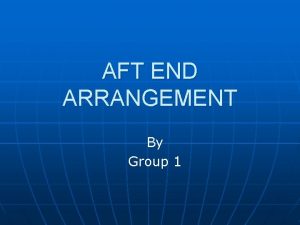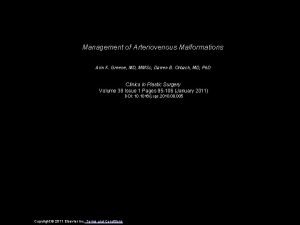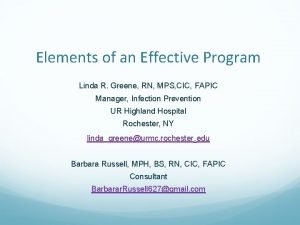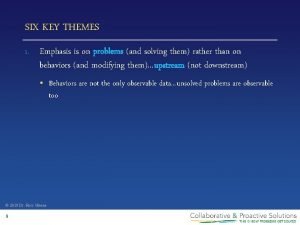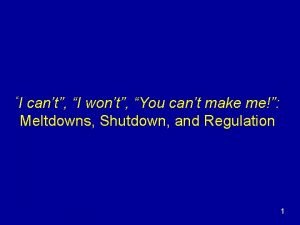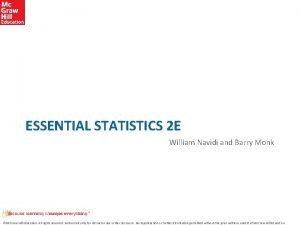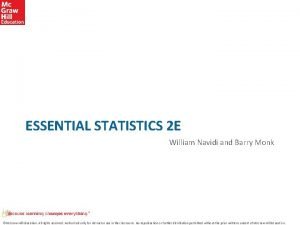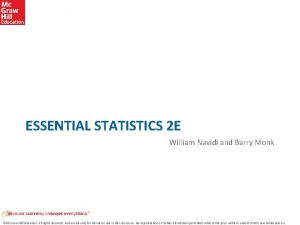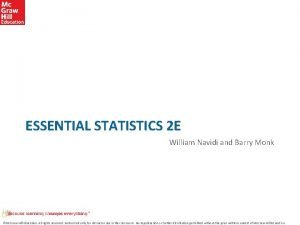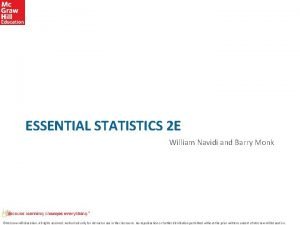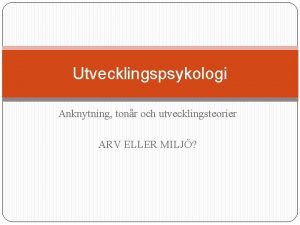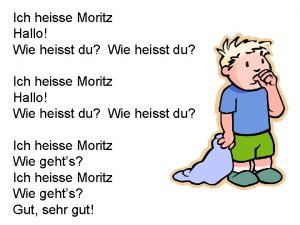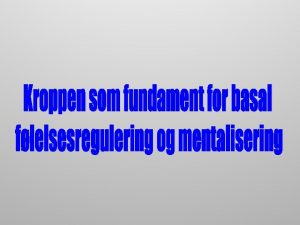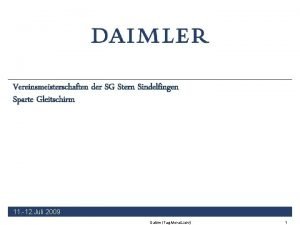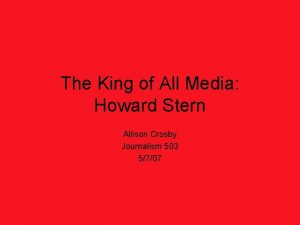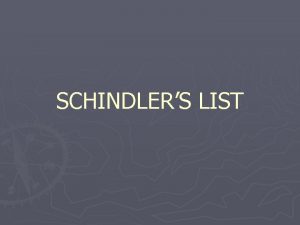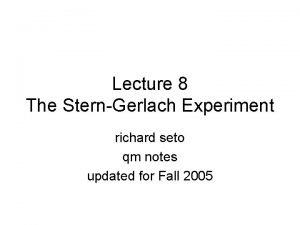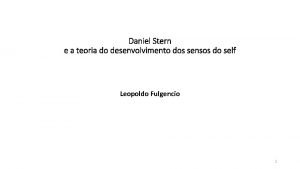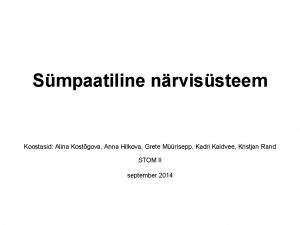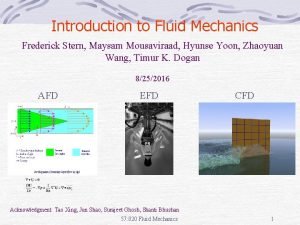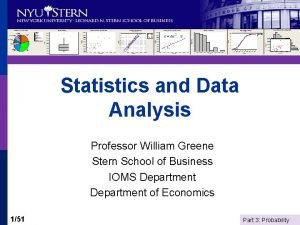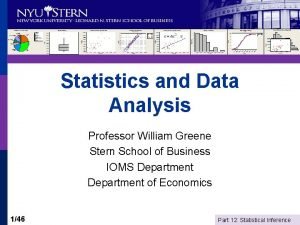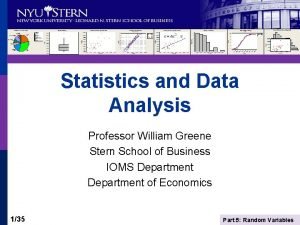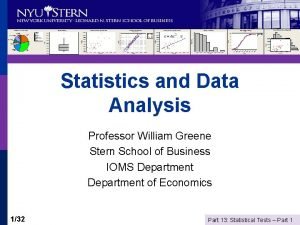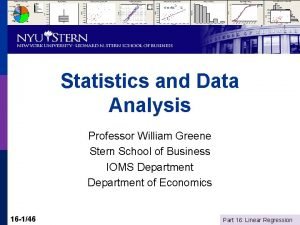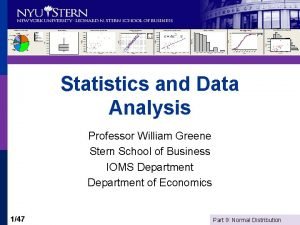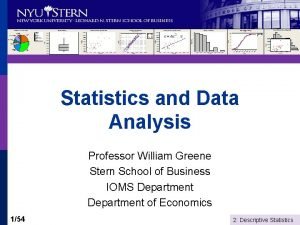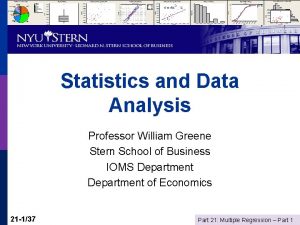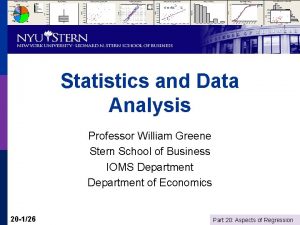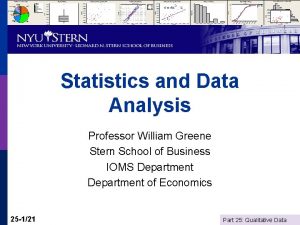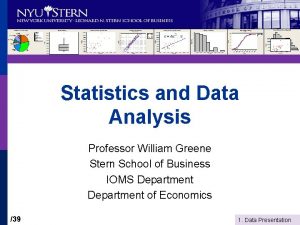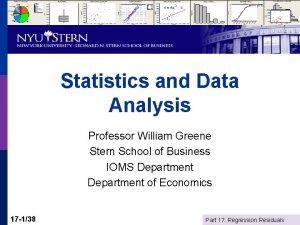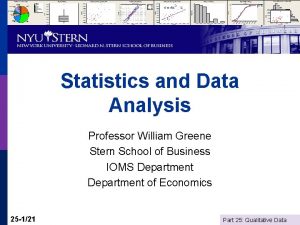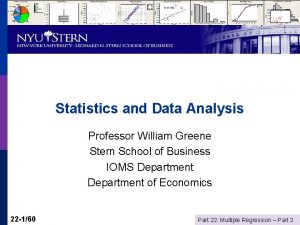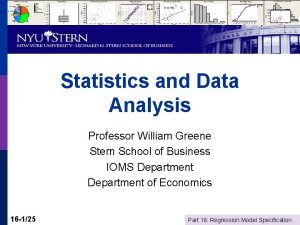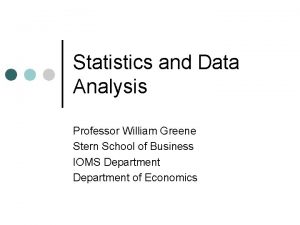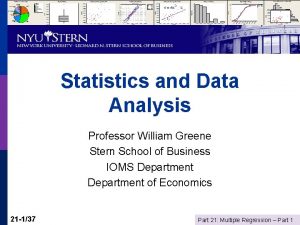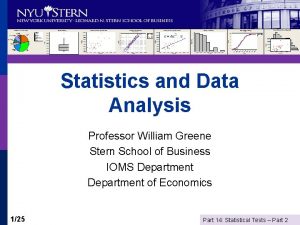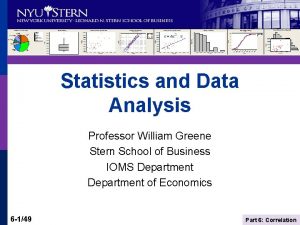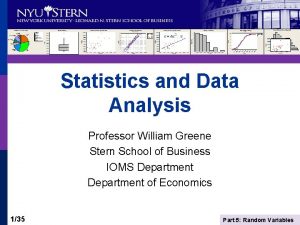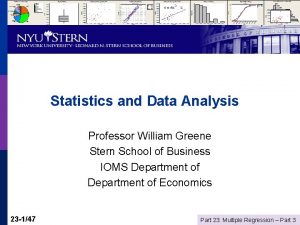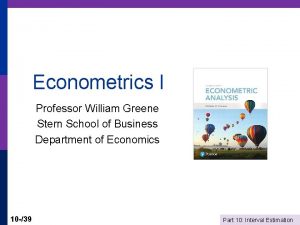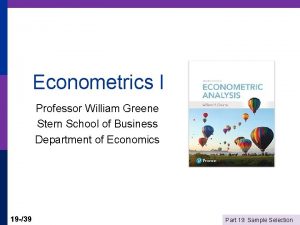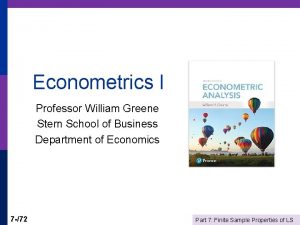Statistics and Data Analysis Professor William Greene Stern













































- Slides: 45

Statistics and Data Analysis Professor William Greene Stern School of Business IOMS Department of Economics 24 -1/45 Part 24: Multiple Regression – Part 4

Statistics and Data Analysis Part 24 – Multiple Regression: 4 24 -2/45 Part 24: Multiple Regression – Part 4

Hypothesis Tests in Multiple Regression Simple regression: Test β = 0 p Testing about individual coefficients in a multiple regression p R 2 as the fit measure in a multiple regression p n n n 24 -3/45 Testing R 2 = 0 Testing about sets of coefficients Testing whether two groups have the same model Part 24: Multiple Regression – Part 4

Regression Analysis p p p Investigate: Is the coefficient in a regression model really nonzero? Testing procedure: n Model: y = α + βx + ε n Hypothesis: H 0: β = 0. n Rejection region: Least squares coefficient is far from zero. Test: n α level for the test = 0. 05 as usual Degrees of n Compute t = b/Standard. Error Freedom for n Reject H 0 if t is above the critical value p p n 24 -4/45 the t statistic is N-2 1. 96 if large sample Value from t table if small sample. Reject H 0 if reported P value is less than α level Part 24: Multiple Regression – Part 4

Application: Monet Paintings p p Does the size of the painting really explain the sale prices of Monet’s paintings? Investigate: Compute the regression Hypothesis: The slope is actually zero. Rejection region: Slope estimates that are very far from zero. The hypothesis that β = 0 is rejected 24 -5/45 Part 24: Multiple Regression – Part 4

An Equivalent Test p p p Is there a relationship? H 0: No correlation Rejection region: Large R 2. Test: F= Reject H 0 if F > 4 Math result: F = t 2. Degrees of Freedom for the F statistic are 1 and N-2 24 -6/45 Part 24: Multiple Regression – Part 4

Partial Effects in a Multiple Regression p p Hypothesis: If we include the signature effect, size does not explain the sale prices of Monet paintings. Test: Compute the multiple regression; then H 0: β 1 = 0. Degrees of p α level for the test = 0. 05 as usual p Rejection Region: Large value of b 1 (coefficient) Test based on t = b 1/Standard. Error p Freedom for the t statistic is N-3 = N-number of predictors – 1. Regression Analysis: ln (US$) versus ln (Surface. Area), Signed The regression equation is ln (US$) = 4. 12 + 1. 35 ln (Surface. Area) + 1. 26 Signed Predictor Coef SE Coef T P Constant 4. 1222 0. 5585 7. 38 0. 000 ln (Surface. Area) 1. 3458 0. 08151 16. 51 0. 000 Reject H 0. Signed 1. 2618 0. 1249 10. 11 0. 000 S = 0. 992509 R-Sq = 46. 2% R-Sq(adj) = 46. 0% 24 -7/45 Part 24: Multiple Regression – Part 4

Use individual “T” statistics. T > +2 or T < -2 suggests the variable is “significant. ” T for Log. PCMacs = +9. 66. This is large. 24 -8/45 Part 24: Multiple Regression – Part 4

Women appear to assess health satisfaction differently from men. 24 -9/45 Part 24: Multiple Regression – Part 4

Or do they? Not when other things are held constant 24 -10/45 Part 24: Multiple Regression – Part 4

24 -11/45 Part 24: Multiple Regression – Part 4

Confidence Interval for Regression Coefficient p Coefficient on Own. Rent n n n p Estimate = +0. 040923 Standard error = 0. 007141 Confidence interval 0. 040923 ± 1. 96 X 0. 007141 (large sample) = 0. 040923 ± 0. 013996 = 0. 02693 to 0. 05492 Form a confidence interval for the coefficient on Self. Empl. (Left for the reader) 24 -12/45 Part 24: Multiple Regression – Part 4

Model Fit How well does the model fit the data? p R 2 measures fit – the larger the better p n n Time series: expect. 9 or better Cross sections: it depends Social science data: . 1 is good p Industry or market data: . 5 is routine p p 24 -13/45 Use R 2 to compare models and find the right model Part 24: Multiple Regression – Part 4

Dear Prof William I hope you are doing great. I have got one of your presentations on Statistics and Data Analysis, particularly on regression modeling. There you said that R squared value could come around. 2 and not bad for large scale survey data. Currently, I am working on a large scale survey data set data (1975 samples) and r squared value came as. 30 which is low. So, I need to justify this. I thought to consider your presentation in this case. However, do you have any reference book which I can refer while justifying low r squared value of my findings? The purpose is scientific article. 24 -14/45 Part 24: Multiple Regression – Part 4

Pretty Good Fit: R 2 =. 722 Regression of Fuel Bill on Number of Rooms 24 -15/45 Part 24: Multiple Regression – Part 4

A Huge Theorem 24 -16/45 p R 2 always goes up when you add variables to your model. p Always. Part 24: Multiple Regression – Part 4

The Adjusted R Squared Adjusted R 2 penalizes your model for obtaining its fit with lots of variables. Adjusted R 2 = 1 – [(N-1)/(N-K-1)]*(1 – R 2) p Adjusted R 2 is denoted p Adjusted R 2 is not the mean of anything and it is not a square. This is just a name. p 24 -17/45 Part 24: Multiple Regression – Part 4

The Adjusted R Squared S = 0. 952237 R-Sq = 57. 0% R-Sq(adj) = 56. 6% Analysis of Variance Source Regression Residual Error Total DF 20 2177 2197 SS 2617. 58 1974. 01 4591. 58 MS 130. 88 0. 91 F 144. 34 P 0. 000 If N is very large, R 2 and Adjusted R 2 will not differ by very much. 2198 is quite large for this purpose. 24 -18/45 Part 24: Multiple Regression – Part 4

Success Measure Hypothesis: There is no regression. p Equivalent Hypothesis: R 2 = 0. p How to test: For now, rough rule. p Look for F > 2 for multiple regression (Critical F was 4 for simple regression) F = 144. 34 for Movie Madness 24 -19/45 Part 24: Multiple Regression – Part 4

Testing “The Regression” Degrees of Freedom for the F statistic are K and N-K-1 24 -20/45 Part 24: Multiple Regression – Part 4

The F Test for the Model Determine the appropriate “critical” value from the table. p Is the F from the computed model larger than theoretical F from the table? p n n 24 -21/45 Yes: Conclude the relationship is significant No: Conclude R 2= 0. Part 24: Multiple Regression – Part 4

n 1 = Number of predictors n 2 = Sample size – number of predictors – 1 24 -22/45 Part 24: Multiple Regression – Part 4

Movie Madness Regression S = 0. 952237 R-Sq = 57. 0% R-Sq(adj) = 56. 6% Analysis of Variance Source Regression Residual Error Total 24 -23/45 DF 20 2177 2197 SS 2617. 58 1974. 01 4591. 58 MS 130. 88 0. 91 F 144. 34 P 0. 000 Part 24: Multiple Regression – Part 4

Compare Sample F to Critical F 24 -24/45 p F = 144. 34 for Movie Madness p Critical value from the table is 1. 57. p Reject the hypothesis of no relationship. Part 24: Multiple Regression – Part 4

An Equivalent Approach p p p 24 -25/45 What is the “P Value? ” We observed an F of 144. 34 (or, whatever it is). If there really were no relationship, how likely is it that we would have observed an F this large (or larger)? n Depends on N and K n The probability is reported with the regression results as the P Value. Part 24: Multiple Regression – Part 4

The F Test S = 0. 952237 R-Sq = 57. 0% R-Sq(adj) = 56. 6% Analysis of Variance Source Regression Residual Error Total 24 -26/45 DF 20 2177 2197 SS 2617. 58 1974. 01 4591. 58 MS 130. 88 0. 91 F 144. 34 P 0. 000 Part 24: Multiple Regression – Part 4

A Cost “Function” Regression The regression is “significant. ” F is huge. Which variables are significant? Which variables are not significant? 24 -27/45 Part 24: Multiple Regression – Part 4

What About a Group of Variables? p Is Genre significant in the movie model? n n n p 24 -28/45 There are 12 genre variables Some are “significant” (fantasy, mystery, horror) some are not. Can we conclude the group as a whole is? Maybe. We need a test. Part 24: Multiple Regression – Part 4

Theory for the Test p p p 24 -29/45 A larger model has a higher R 2 than a smaller one. (Larger model means it has all the variables in the smaller one, plus some additional ones) Compute this statistic with a calculator Part 24: Multiple Regression – Part 4

Is Genre Significant? Calc -> Probability Distributions -> F… The critical value shown by Minitab is 1. 76 With the 12 Genre indicator variables: R-Squared = 57. 0% Without the 12 Genre indicator variables: R-Squared = 55. 4% The F statistic is 6. 750. F is greater than the critical value. Reject the hypothesis that all the genre coefficients are zero. 24 -30/45 Part 24: Multiple Regression – Part 4

Now What? If the value that Minitab shows you is less than your F statistic, then your F statistic is large p I. e. , conclude that the group of coefficients is “significant” p This means that at least one is nonzero, not that all necessarily are. p 24 -31/45 Part 24: Multiple Regression – Part 4

Application: Part of a Regression Model p p p 24 -32/45 Regression model includes variables x 1, x 2, … I am sure of these variables. Maybe variables z 1, z 2, … I am not sure of these. Model: y = α+β 1 x 1+β 2 x 2 + δ 1 z 1+δ 2 z 2 + ε Hypothesis: δ 1=0 and δ 2=0. Strategy: Start with model including x 1 and x 2. Compute R 2. Compute new model that also includes z 1 and z 2. Rejection region: R 2 increases a lot. Part 24: Multiple Regression – Part 4

Test Statistic 24 -33/45 Part 24: Multiple Regression – Part 4

Gasoline Market 24 -34/45 Part 24: Multiple Regression – Part 4

Gasoline Market Regression Analysis: log. G versus log. Income, log. PG The regression equation is log. G = - 0. 468 + 0. 966 log. Income - 0. 169 log. PG Predictor Coef SE Coef T P Constant -0. 46772 0. 08649 -5. 41 0. 000 log. Income 0. 96595 0. 07529 12. 83 0. 000 log. PG -0. 16949 0. 03865 -4. 38 0. 000 S = 0. 0614287 R-Sq = 93. 6% R-Sq(adj) = 93. 4% Analysis of Variance Source DF SS MS F P Regression 2 2. 7237 1. 3618 360. 90 0. 000 Residual Error 49 0. 1849 0. 0038 Total 51 2. 9086 R 2 = 2. 7237/2. 9086 = 0. 93643 24 -35/45 Part 24: Multiple Regression – Part 4

Gasoline Market Regression Analysis: log. G versus log. Income, log. PG, . . . The regression equation is log. G = - 0. 558 + 1. 29 log. Income - 0. 0280 log. PG - 0. 156 log. PNC + 0. 029 log. PUC - 0. 183 log. PPT Predictor Coef SE Coef T P Constant -0. 5579 0. 5808 -0. 96 0. 342 log. Income 1. 2861 0. 1457 8. 83 0. 000 log. PG -0. 02797 0. 04338 -0. 64 0. 522 log. PNC -0. 1558 0. 2100 -0. 74 0. 462 log. PUC 0. 0285 0. 1020 0. 28 0. 781 log. PPT -0. 1828 0. 1191 -1. 54 0. 132 S = 0. 0499953 R-Sq = 96. 0% R-Sq(adj) = 95. 6% Analysis of Variance Source DF SS MS F P Regression 5 2. 79360 0. 55872 223. 53 0. 000 Residual Error 46 0. 11498 0. 00250 Total 51 2. 90858 Now, R 2 = 2. 7936/2. 90858 = 0. 96047 Previously, R 2 = 2. 7237/2. 90858 = 0. 93643 24 -36/45 Part 24: Multiple Regression – Part 4

24 -37/45 Part 24: Multiple Regression – Part 4

n 1 = Number of predictors n 2 = Sample size – number of predictors – 1 24 -38/45 Part 24: Multiple Regression – Part 4

Improvement in R 2 Inverse Cumulative Distribution Function F distribution with 3 DF in numerator and 46 DF in denominator P( X <= x ) = 0. 95 x = 2. 80684 The null hypothesis is rejected. Notice that none of the three individual variables are “significant” but the three of them together are. 24 -39/45 Part 24: Multiple Regression – Part 4

Application p Health satisfaction depends on many factors: n n p p p 24 -40/45 Age, Income, Children, Education, Marital Status Do these factors figure differently in a model for women compared to one for men? Investigation: Multiple regression Null hypothesis: The regressions are the same. Rejection Region: Estimated regressions that are very different. Part 24: Multiple Regression – Part 4

Equal Regressions Setting: Two groups of observations (men/women, countries, two different periods, firms, etc. ) p Regression Model: y = α+β 1 x 1+β 2 x 2 + … + ε p Hypothesis: The same model applies to both groups p Rejection region: Large values of F p 24 -41/45 Part 24: Multiple Regression – Part 4

Procedure: Equal Regressions p p p There are N 1 observations in Group 1 and N 2 in Group 2. There are K variables and the constant term in the model. This test requires you to compute three regressions and retain the sum of squared residuals from each: n n n p 24 -42/45 SS 1 = sum of squares from N 1 observations in group 1 SS 2 = sum of squares from N 2 observations in group 2 SSALL = sum of squares from NALL=N 1+N 2 observations when the two groups are pooled. The hypothesis of equal regressions is rejected if F is larger than the critical value from the F table (K numerator and NALL-2 K-2 denominator degrees of freedom) Part 24: Multiple Regression – Part 4

Health Satisfaction Models: Men vs. Women German survey data over 7 years, 1984 to 1991 (with a gap). 27, 326 observations on Health Satisfaction and several covariates. 24 -43/45 +--------------+--------+--------+-----+ |Variable| Coefficient | Standard Error | T |P value]| Mean of X| +--------------+--------+--------+-----+ Women===|=[NW = 13083]======================== Constant| 7. 05393353. 16608124 42. 473. 0000 1. 0000000 AGE | -. 03902304. 00205786 -18. 963. 0000 44. 4759612 EDUC |. 09171404. 01004869 9. 127. 0000 10. 8763811 HHNINC |. 57391631. 11685639 4. 911. 0000. 34449514 HHKIDS |. 12048802. 04732176 2. 546. 0109. 39157686 MARRIED |. 09769266. 04961634 1. 969. 0490. 75150959 Men=====|=[NM = 14243]======================== Constant| 7. 75524549. 12282189 63. 142. 0000 1. 0000000 AGE | -. 04825978. 00186912 -25. 820. 0000 42. 6528119 EDUC |. 07298478. 00785826 9. 288. 0000 11. 7286996 HHNINC |. 73218094. 11046623 6. 628. 0000. 35905406 HHKIDS |. 14868970. 04313251 3. 447. 0006. 41297479 MARRIED |. 06171039. 05134870 1. 202. 2294. 76514779 Both====|=[NALL = 27326]======================= Constant| 7. 43623310. 09821909 75. 711. 0000000 AGE | -. 04440130. 00134963 -32. 899. 0000 43. 5256898 EDUC |. 08405505. 00609020 13. 802. 0000 11. 3206310 HHNINC |. 64217661. 08004124 8. 023. 0000. 35208362 HHKIDS |. 12315329. 03153428 3. 905. 0001. 40273000 MARRIED |. 07220008. 03511670 2. 056. 0398. 75861817 Part 24: Multiple Regression – Part 4

Computing the F Statistic +----------------------------------------+ | Women Men All | | HEALTH Mean = 6. 634172 6. 924362 6. 785662 | | Standard deviation = 2. 329513 2. 251479 2. 293725 | | Number of observs. = 13083 14243 27326 | | Model size Parameters = 6 6 6 | | Degrees of freedom = 13077 14237 27320 | | Residuals Sum of squares = 66677. 66 66705. 75 133585. 3 | | Standard error of e = 2. 258063 2. 164574 2. 211256 | | Fit R-squared = 0. 060762 0. 076033. 070786 | | Model test F (P value) = 169. 20(. 000) 234. 31(. 000) 416. 24 (. 0000) | +----------------------------------------+ 24 -44/45 Part 24: Multiple Regression – Part 4

Summary Simple regression: Test β = 0 p Testing about individual coefficients in a multiple regression p R 2 as the fit measure in a multiple regression p n n n 24 -45/45 Testing R 2 = 0 Testing about sets of coefficients Testing whether two groups have the same model Part 24: Multiple Regression – Part 4
 Transom stern and cruiser stern
Transom stern and cruiser stern Promotion from associate professor to professor
Promotion from associate professor to professor Kylie greene
Kylie greene The tenth man graham greene summary
The tenth man graham greene summary Stoke's theorem
Stoke's theorem The destructors graham greene
The destructors graham greene Adaptive challenges examples
Adaptive challenges examples Heart of darkness
Heart of darkness Robert greene shakespeare
Robert greene shakespeare Arin greene
Arin greene Linda r greene
Linda r greene Alsup ross greene
Alsup ross greene Ross greene plan a b c
Ross greene plan a b c Maxine greene releasing the imagination
Maxine greene releasing the imagination Ericka simpson md
Ericka simpson md Eric greene course
Eric greene course Charismatic conversation secrets
Charismatic conversation secrets Uzuri pease-greene
Uzuri pease-greene Jody greene ucsc
Jody greene ucsc Introduction to statistics what is statistics
Introduction to statistics what is statistics Essential statistics william navidi pdf
Essential statistics william navidi pdf Essential statistics william navidi pdf
Essential statistics william navidi pdf William navidi essential statistics pdf
William navidi essential statistics pdf Essential statistics william navidi pdf
Essential statistics william navidi pdf William navidi elementary statistics pdf
William navidi elementary statistics pdf Personal network analysis
Personal network analysis Stern utvecklingspsykologi
Stern utvecklingspsykologi Stern village trumbull ct
Stern village trumbull ct Stern of a vessel
Stern of a vessel Dr theodore stern
Dr theodore stern Vertical wall like structure enclosing a compartment
Vertical wall like structure enclosing a compartment Experimento de stern-gerlach
Experimento de stern-gerlach Bow stern port starboard
Bow stern port starboard Polimotor
Polimotor Ich heisse du
Ich heisse du Ady stern
Ady stern Daniel stern model
Daniel stern model Sg stern sindelfingen
Sg stern sindelfingen Howard stern allison
Howard stern allison Itshak stern
Itshak stern Ben kingsley som itzak stern
Ben kingsley som itzak stern Stern-gerlach experiment lecture notes
Stern-gerlach experiment lecture notes Stern teoria
Stern teoria Grete müürisepp
Grete müürisepp Photomontage history
Photomontage history Fluid mechanics
Fluid mechanics
